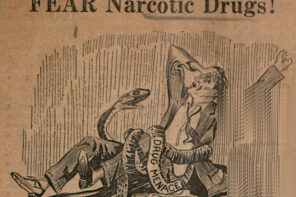This article is part of It’s Your Fault, The Cubit’s series on blame in contemporary society. In her contribution to the series, journalist Xarissa Holdaway examines the American prison system and the fragile relationships among rehabilitation, containment, and revenge.
For more on blame, read the introductory post or explore the full series.
When Louis Dwight died in 1853, the Boston Courier lamented, “we know not who can succeed him; but it is to be hoped that some individual of like spirit and capabilities may be found to take his place.” Dwight was a prominent advocate of prison reform and the founder of the Boston Prison Discipline Society. The Courier obituary did not mince words about the importance of Dwight’s organization: “it would be a very serious evil,” they wrote, “for the society to suspend its operations.”
Dwight was part of a generation of reformers that advocated for more humane conditions in American prisons. Believing that discipline, religion, and encouragement—not punishment—were the keys to successfully returning inmates to society, Dwight spent his career encouraging prisons to adopt regulations that allowed prisoners to attend Sunday schools and spend time out of their cells. Dwight, along with reformers like Dorothea Dix, was responding to nightmarish prison conditions: jails that functioned as warehouses for the mentally ill, widespread imprisonment for debt, and inmates kept in solitary confinement for years at a time or in filthy, unheated, and vermin-ridden cells.
This was in the early 19th century, but the situation doesn’t sound so different from today’s correctional institutions. The number of mentally ill inmates is on the rise, as public psychiatric institutions lose funding. Buildings are overcrowded and under-maintained. Rehabilitation and substance-abuse programs are chronically underfunded. Debt imprisonment no longer exists, but the burden still falls disproportionately on the marginalized: discriminatory policies throughout the justice system mean that black people and Hispanics are incarcerated at six times and twice the rates of whites, respectively, according to the Economist. Despite two centuries of activism, our correctional institutions are rife with violence, mistreatment, racism, and decay.
Yet we continue to pay lip service to the idea that prison should be rehabilitative and correctional. Inmates are supposedly paying their debt to society, and guards are now called “correctional officers.” When a left-wing activist like Van Jones and a libetarian leader like Senator Rand Paul agree that we need a more forgiving and just penal system, it doesn’t seem so far-fetched that our penal system might need to be more, well, forgiving and just.
So why do correctional institutions remain, for most inmates and in most places, not only punitive, but often arbitrarily and unfairly so?
Perhaps we’re not so interested in rehabilitation after all. Patrick J. Nolan, the former Republican leader in the assembly in California, who served time after being caught in an FBI sting known as “Shrimpscam,” said to PBS NewsHour, “I think we have incarcerated a lot of people we’re not afraid of, we’re just mad at.”
Is it possible that, despite all our good intentions and rhetoric, what we’re really looking for is revenge?
Justice does not require revenge
Shortly before his sentencing, Dzhokhar Tsarnaev, the surviving perpetrator of the Boston bombing, stood in the courtroom and spoke to victims for the first time in a two-year trial. Tsarnaev said that he was “sorry for the lives I’ve taken” and that he would “pray for your relief, for your healing, for your well-being, for your strength.”
Judge George A. O’Toole Jr., then sentenced Tsarnaev to six death sentences, 20 sentences of life in prison, and several shorter sentences of prison time.
For some of the victims, it seemed as if no apology or sentence could have gone far enough. Lynn Julian, who sustained a brain injury as a result of the attack, said, “I regret having ever wanted to hear him speak, because what he said showed no remorse, no regret, no empathy for what he’s done to our lives.”
As far as the government is concerned, neither Tsarnaev’s devout, late-breaking apology nor the victims’ preferences are, or should be, primary factors during sentencing. In many cases, this is a good thing; the state is meant to intervene between us and our most vengeful impulses, substituting the rule of law for the desire for retribution, a social contract we’ve been using more or less since the Enlightenment
The key factor, of course, is that such justice must be fair and proportionate to the crime. Punishment should only go so far “as calm reason and conscience dictates,” John Locke argues in “Two Treatises of Government,” one of our foundational texts on crime and punishment. For Locke, a criminal’s punishment must be “proportionate to his Trangression” and only “serve for Reparation and Restraint.” Locke leaves little room for hot-blooded vengeance.
At least in theory, those principles shape our justice system today. In practice, we aren’t always so guided by calm reason and conscience. For example, while Tsarnaev’s lawyers plan his appeal against the death penalty, he is being held at the U.S. Penitentiary Administrative Maximum Facility in Florence, Colorado, the highest-security prison in the country, which the New York Times called “America’s Toughest Federal Prison.”
Most inmates spend 23 hours a day in solitary confinement (similar to the practice Dwight fought against in the 1830s), and even visits with chaplains and psychiatrists come through the same door slit where food arrives. The facility was recently sued for its treatment of mentally ill inmates; one of the lesser charges was the denial of prescribed psychiatric drugs. Even the strongest proponents of the death penalty would have a hard time arguing that a life sentence there would be getting off easy, much less that it’s a rehabilitative environment.
Few would question the desire for revenge in cases like the Boston Bombing, where several people died and hundreds of others were wounded and traumatized. It seems somehow natural for the state to seek retribution. And, of course, some people must be kept away from the general population if we know they pose a risk of violence.
Yet our commitment to punishment goes well beyond the need for containment. In 2000, Morgan Reynolds of the Texas-based National Center for Policy Analysis testified before Congress,
Public opinion strongly supports the increased use of prisons to give criminals their just desserts. The endorsement of punishment is relatively uniform across all groups. More than three-quarters of the public see punishment as the primary justification for sentencing. More than 70 percent believe that incapacitation is the only sure way to prevent future crimes, and more than three-quarters believe that the courts are too easy on criminals.
This appears to be true not just for capital-C crimes like murder and terrorism, but smaller crimes, including procedural, immigration, and drug-based felonies, few of which are violent. Nolan notes in his memoir that many of his prison companions were non-violent drug offenders and even elderly or infirm. He writes that “incarcerating people who aren’t a physical threat to society is expensive and counter-productive,” something that “only a nation that is rich and vindictive would do.”
The impulse is mistaken, as justice and revenge are quite different. Justice is meant to be impersonal, balanced, and fair to both the accuser and the accused. Revenge is red-blooded, vindicating, even pleasurable: think of the phrases “sweet revenge” and “just desserts.” When we have been wronged, our inclination is to blame and punish out of all proportion to the offense, reacting with what Locke called “the passionate heats” of our will.
There’s some evidence that even thinking about revenge activates the reward centers of our brains, which makes the admonition “an eye for an eye” in Hammurabi’s code sound less like savagery and more like a way to keep everybody in check. To punish more than the guilt deserves has been a legal problem, apparently, since at least 1792 B.C.E or so.
The distinction between justice and vengeance matters, because vengeance costs an enormous amount to taxpayers, and, as reformers on both sides of the aisle argue, our own moral selves. Perhaps most importantly, there is little evidence that revenge helps victims, writes journalist Ellis Cose, who reported on the after-effects of crimes ranging from murder to the attacks on the World Trade Center and apartheid for his book Bone to Pick: Of Forgiveness, Reconciliation, Reparation, and Revenge.
Cose writes that “for every survivor who responds to an execution with a shouted ‘Hallelujah! The wicked beast is dead,’ there seems to be another who wonders why the pain won’t stop, who knows that nothing that anyone could do to a perpetrator will make up for what has already been lost. Revenge may be one of the oldest impulses around, but it doesn’t always lead people to a state of peace.”
The difficulty of reform is, as ever, that we still haven’t decided what it is we’re correcting for. The idea of rehabilitation is relatively new. At least originally, it was driven by Christian denominations that emphasized compassion for the sinner, mercy, and individual progress. In an increasingly pluralistic and secularizing country, that conversation can get stickier. Many evangelical activist groups, for example, have been faulted for teaching prisoners that the only true way to reform themselves is through belief in a particular doctrine.
The thing is, we do believe, powerfully, in the possibility of redemption: consider the case of Michael Geoghegan, who spent 35 years incarcerated at U.S. Penitentiary-Marion, a maximum-security prison in Illinois reserved for the “worst of the worst,” and now works with the local diocese on the Faith Alliance Initiative for Transitional Healing (FAITH) program, which helps inmates move back into society.
After a profile appeared on npr.com, a commenter with the handle Janis Spotts wrote, “I spent 4 years working in the MDOC as a nurse. I’m not naive about the evil that many had performed, but the treatment in prison only degrades the remains of the soul. Thank you for sharing this story-it gave me hope that change is possible-especially if it happens inside the soul.” She was joined by dozens of others who echoed the hope that more inmates like Geoghegan might find ways to re-enter society. It does seem ironic that a national consciousness that prides itself on self-improvement and personal progress is very nearly exempting a lot of people as soon as they end up in the criminal justice system.
So why the gap between our aspirations and our reality? Perhaps the answer is as simple as it is difficult to fix: a combination of national drug war policy, “tough on crime” political posturing, local prosecutorial decisions, reduced budgets, mandatory minimum sentencing, psychiatric deinstitutionalization, and prison privatization have combined to land us in a bureaucratic nightmare that no one quite intended and that we don’t know how to get out of.
These are almost certainly factors, but they don’t tell the whole story, which is older than the Bible (and perhaps older than humanity itself, as even birds and fish have impulses towards revenge). The sting of unfair treatment is so powerful that that we mythologize vigilante superheroes, reform our laws, and attack other nations because of it.
All the more reason to make a change in the way we handle our prisons. It’s nearly impossible to claim that the current system, where inmates languish in long-term punishment centers and return to a world they’re even less prepared for than when they entered, is fair. And inmates know it.
Geoghegan says, “You’re breeding this hatred, you’re breeding this anger, you’re breeding this animosity into them, and then you’re going to let them loose on society. And then when they do something wrong, you’re going to say, ‘See? I told you that guy’s bad.’”
“But if you can work on the individual and give them a sense of dignity,” continues Geoghegan, “maybe they won’t come out with so much anger and hostility.”





